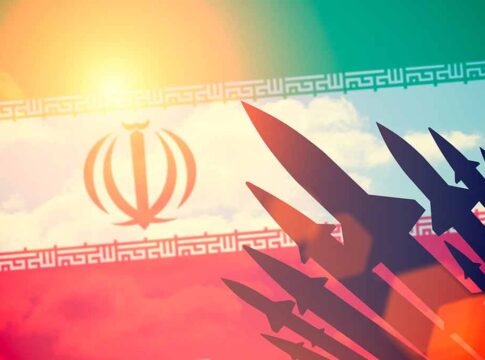Iran intends to ratchet up tensions in the Middle East. Iran unveils a new ballistic missile capable of striking US military bases around the world, raising tensions between the two countries as nuclear talks stall. Iran has unveiled the “Qassem Basir,” a solid-fueled ballistic missile with a range of 1,200 kilometers (745 miles). The unveiling comes amid deteriorating US-Iran relations and postponed nuclear talks.
Advanced Missile Technology Demonstrated
Iran’s Defense Ministry has unveiled a new solid-fueled ballistic missile called “Qassem Basir” with a range of 1,200 kilometers (745 miles), capable of executing precision strikes without relying on satellite guidance. Defense Minister General Aziz Nasirzadeh announced the missile can identify and strike targets with pinpoint accuracy independent of GPS systems, a capability that would allow Iran to maintain strike capabilities even if satellite navigation were compromised during conflict. The missile was successfully tested on April 17, according to Iranian state media reports.
The technology represents a significant advancement in Iran’s missile program, which initially developed in response to Iraqi Scud missile attacks during the 1980-1988 Iran-Iraq War. The solid-fuel propulsion system enables faster launch preparations compared to liquid-fueled missiles and provides enhanced mobility and storage stability. Iranian officials claim the missile is positioned throughout the country and can overcome anti-ballistic missile defense systems like those deployed by the United States.
Israel must act soon.
……Iran has unveiled a new ballistic missile called the Qassem-Bissat, which is effective for a minimum range of 1,200 km and is claimed to be "capable of penetrating the THAAD battery's protective layer."
AmirTsarfati pic.twitter.com/dd0TruGTWK— Sue (@SimplySusie3) May 4, 2025
Direct Threats Against U.S. Military Positions
General Nasirzadeh issued explicit warnings that American military assets would become targets if hostilities break out. “If the Americans or Israelis make a mistake, Iranian missiles will target their interests and bases wherever they are,” he stated during the missile’s unveiling ceremony. The announcement comes as indirect U.S.-Iran talks scheduled for May 3 in Rome were postponed, further straining diplomatic channels between the nations.
“We have no hostility toward neighboring countries and seek brotherly relations, but in the event of an attack, US bases in the region will be considered legitimate targets.” – Gen. Aziz Nasirzadeh
Former Iranian diplomat Amir Mousavi recently admitted that Iran uses negotiations to advance its interests while maintaining hostility toward the United States and Israel. This acknowledgment highlights concerns that Iran may be using diplomatic engagement as cover while continuing to develop military capabilities and support proxy forces throughout the Middle East, including groups like Yemen’s Houthi rebels, who recently launched missile attacks on Israel’s main airport.
Iran has introduced a new missile with a 1200km range. This is why Iranian regime must be destroyed pic.twitter.com/72F087XorL
— The Jewish Warrior 🇮🇱✡️ (@CoolJew09) May 4, 2025
Deepening Nuclear Concerns
President Donald Trump has threatened airstrikes on Iran if nuclear negotiations fail to produce an agreement limiting Iran’s atomic program. The missile unveiling occurs as Iranian officials have increasingly suggested they might pursue nuclear weapons, citing their stockpile of uranium enriched to near weapons-grade levels. Iran has already accumulated uranium enriched to 60% purity, just below the 90% threshold needed for weapons production.
The missile demonstration represents a hardened stance from Tehran at a critical juncture in U.S.-Iran relations. Israeli Prime Minister Benjamin Netanyahu has expressed support for President Trump’s position on Iran, connecting recent Houthi attacks to Iranian influence in the region. Meanwhile, U.S. officials continue to designate Iran as the world’s leading state sponsor of terrorism, funding numerous proxy groups while reportedly executing over 1,000 prisoners domestically in 2024.
Regional Security Implications
The Qassem Basir missile announcement follows an escalation in regional hostilities, including a missile attack by Yemen’s Houthi rebels on Israel that resulted in injuries and disrupted airport operations. U.S. warnings against Iran’s support for the Houthis have seemingly gone unheeded, with Iran maintaining its backing of proxy forces across the Middle East. The missile’s name itself carries significance, commemorating Qassem Soleimani, the former commander of Iran’s Quds Force killed in a U.S. drone strike in 2020.
The timing of the missile unveiling appears calculated to demonstrate Iran’s military capabilities amid deteriorating relations with the United States. President Trump has warned that Iran’s pursuit of nuclear weapons would close its path back to the global community, while Iranian threats have escalated to include calls to assassinate Trump and target other U.S. officials. This continuing cycle of provocations threatens to further destabilize an already volatile region.


